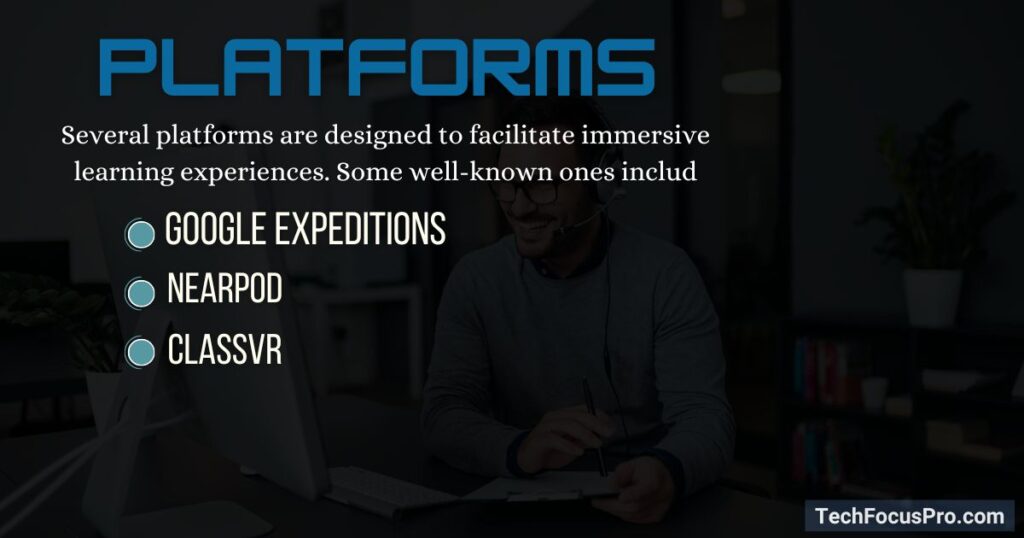Immersive Tech Gadgets for Effective Online Learning

There are benefits and drawbacks to the move to online education. Although having the ability to learn from anywhere is very convenient, maintaining student engagement can be challenging.
Thankfully, advances in technology are helping to close this gap. Immersion technology is changing the way students engage with the curriculum and increasing the effectiveness of learning.
Thanks to devices like smart speakers and virtual reality headsets, learning is no longer limited to textbooks and displays. With these devices, students can study topics in a way that feels both interesting and authentic.
This article will show you how cutting-edge technology is changing the face of online education.
The Rise of Immersive Technology in Education
Immersive technology, including virtual reality (VR), augmented reality (AR), and mixed reality (MR), has changed how we approach education.
These technologies allow students to interact with digital environments in ways that were impossible before.
Instead of just reading about a topic or watching a video, students can now dive into a virtual world and experience learning firsthand.
Virtual Reality (VR)

With Virtual Reality headsets like the Oculus Rift and HTC Vive, students can enter simulated environments that replicate real-world scenarios. This is especially beneficial in fields like medicine, engineering, and architecture, where hands-on experience is crucial.
For example, medical students can use VR to practice surgeries without the risk of harming actual patients.
Similarly, architecture students can walk through their designs in a virtual space, making adjustments in real-time.
Augmented Reality (AR)

Augmented reality (AR) modifies the real world by placing digital data. In contrast, virtual reality (VR) fully submerges you in a digital environment.
Thanks to devices like Microsoft HoloLens and smartphones with augmented reality capabilities, students may engage with digital objects as if they were real-world objects.
Let’s say a biology student is learning about the human body. They can investigate a 3D model of the human body with augmented reality, focussing on specific organs and systems to gain a thorough understanding.
Headphones and Earbuds – Focus on Learning
Headphones and earbuds are more than simply accessories in the realm of online learning. They are necessary to establish a concentrated learning environment, particularly in loud settings.
Noise-canceling Headphones: Tune Out Distractions

For students who need to focus, noise-cancelling headphones like the Bose QuietComfort range are ideal. With these headphones, you can concentrate on your studies without being distracted by outside sounds.
Whether you’re viewing a lesson or participating in a virtual class, noise-canceling headphones can improve your learning process.
Wireless Earbuds: Learning on the Move
Wireless earbuds like the Apple AirPods and AirPods Pro make studying on the go easy. You can listen to audiobooks, podcasts, or lectures while working out or traveling. They are flexible tools for online learning because they pair with your devices easily.
If you need help connecting your AirPods or AirPods Pro to your Mac, iPhone, or Android, be sure to read this to find practical tools for seamlessly integrating your wireless earbuds into your learning routine.
By optimizing your setup, you can enhance your focus and productivity wherever you are.
Wearable Tech – Learning on the Go
Fitness trackers and smartwatches are examples of wearable technology that is starting to appear in the classroom. These gadgets can be effective learning tools, useful for tracking steps, and for checking notifications.
Smartwatches: A Handy Learning Companion
Beyond only tracking your fitness, smartwatches like the Samsung Galaxy Watch and Apple Watch provide extra features. These devices can assist you with staying well-organized, managing your study routine, and even taking brief tests while on the road, thanks to educational apps.
Additionally, you can sign up to receive reminders about impending classes or deadlines, which can help you keep prepared for your studies.
Fitness Trackers: Enhancing Physical Education
Physical education is an important part of the learning process, and fitness trackers can also help. Devices like the Fitbit can track your physical activity, heart rate, and even sleep patterns.
Teachers can use these data to monitor their kids’ physical health and customize PE lessons to each student’s needs. This ensures that students are both intellectually and physically engaged.
Advantages of Using Immersive Tech Gadgets in Online Learning

Enhance Engagement and Motivation for Students
Immersion technology devices, such as AR headsets and VR headsets, enhance the excitement and interactivity of learning. Students can have a realistic learning experience when they use these resources.
For instance, a student can investigate a virtual pyramid rather than learn about ancient Egypt. As opposed to passively listening to a lecture, students are actively immersed in this hands-on experience, which keeps them interested and driven to learn.
Improve Retention of Information Through Experiential Learning
Experiential learning means learning through doing. When students engage with content through immersive technology, they remember information better.
For instance, if a student conducts a science experiment using a simulation, they will likely recall the concepts involved because they have practiced them firsthand.
Studies show that when learners experience something directly, they have a stronger connection to that knowledge, making it easier to remember for tests or future applications.
Afteral,l taking look on immersive tech gadgets we recommend you to also look at Intelliscient Technologies: Impulse of Change in the Tech Industry. It will help you to gain in depth knowledge.
How Can Educators Implement Immersive Tech in Online Learning Environments?

Integrating immersive tech gadgets into online learning can significantly enhance the educational experience.
Here are some helpful tips for educators looking to make this transition:
Tips for Educators to Integrate Tech Gadgets
- Start Small: Begin by incorporating one or two immersive tools into your lessons. For example, you might use a virtual reality headset for a specific topic. This makes it easier to manage and assess its effectiveness.
- Please become Familiar With the Technology. Before using the tools in class, Spend time learning how they work. This will boost your confidence and help you troubleshoot any issues during lessons.
- Encourage Student Interaction: Use platforms that promote collaboration among students. For example, virtual reality environments can allow students to work together on projects or explore scenarios as a team.
- Gather Feedback: After using immersive tech, ask your students what they liked and how they felt about the learning experience. This feedback will help you understand what works best.
Considerations for Choosing Suitable Devices
When selecting gadgets, consider the following factors:
- Subject Matter: Choose technology that aligns with the topics you’re teaching. For science lessons, VR simulations of experiments might be ideal, while AR can enhance historical studies with interactive timelines.
- Budget: Look for cost-effective tools. Some immersive technologies can be expensive, so explore options like mobile apps or less costly devices that still provide a good learning experience.
- Accessibility: Ensure that all students can access the technology. This means checking that devices can cater to different skill levels and learning needs.
Platforms That Support Immersive Learning

Several platforms are designed to facilitate immersive learning experiences. Some well-known ones include:
- Google Expeditions: This platform allows teachers to take students on virtual field trips around the world using VR.
- Nearpod: With features like VR lessons and interactive assessments, Nearpod helps educators create engaging lessons.
- ClassVR: This platform provides a variety of VR experiences and content that educators can use directly in their curriculum.
By thoughtfully implementing immersive tech gadgets, educators can create a more engaging and effective online learning environment for their students.
FAQs
What is immersive technology in online learning?
The term “immersive technology” describes the instruments and systems that use mixed reality (MR), augmented reality (AR), and virtual reality (VR) to produce an immersive learning environment. These technological advancements improve students’ learning experience by enabling more realistic and dynamic interactions with the curriculum.
How can I start using immersive tech gadgets in my classroom?
Start by familiarizing yourself with the various technologies available and selecting a couple that fit your course of study. Start small and progressively add more of these tools to lessons as you and your students become more accustomed to using them.
Are immersive tech gadgets suitable for all age groups?
Immersion technology is adaptable to all age groups and learning preferences. Many platforms include content that is appropriate for varying educational levels, so both adults and younger kids can access it.
What are some examples of immersive learning experiences?
Virtual reality simulations of science experiments, virtual field visits to historical locations, and augmented reality apps that superimpose instructional content on real-world environments are a few examples. Through these encounters, students can learn and explore in ways that may not be possible with standard teaching approaches.
What is the cost of implementing immersive tech in education?
Depending on the technology selected, costs differ significantly, from inexpensive smartphone apps to more costly VR gear and software. It’s a good idea to look at reasonably priced options that nonetheless provide worthwhile educational opportunities.
Final Words
Thanks to technological advancements, the way we approach education is changing rapidly. Immersive tech gadgets are no longer just tools. They are reshaping how we learn, making education more accessible and engaging for everyone. As these technologies continue to evolve, they promise a more personalized and interactive learning experience. The future of learning is bright, and with the right tools at your fingertips, the possibilities are endless.
Picture Credit: Canva, Youtube






